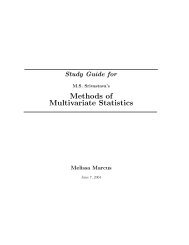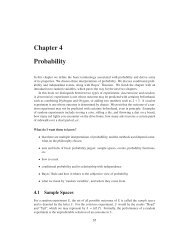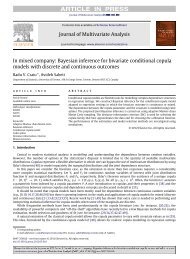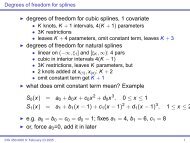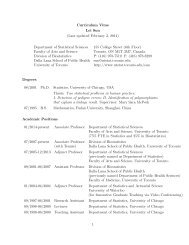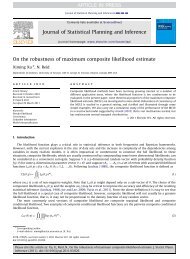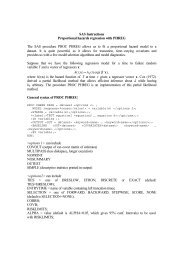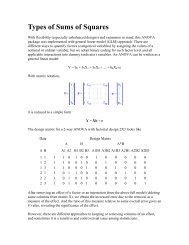Chapter 5 Discrete Distributions
Chapter 5 Discrete Distributions
Chapter 5 Discrete Distributions
You also want an ePaper? Increase the reach of your titles
YUMPU automatically turns print PDFs into web optimized ePapers that Google loves.
5.4. EXPECTATION AND MOMENT GENERATING FUNCTIONS 117<br />
Definition 5.10. More generally, given a function g we define the expected value of g(X) by<br />
This should be a theorem, ∑<br />
not a definition IE g(X) = g(x) f X (x), (5.4.2)<br />
x∈S<br />
provided the (potentially infinite) series ∑ x |g(x)| f (x)isconvergent.WesaythatIEg(X) exists.<br />
In this notation the variance is σ 2 = IE(X − µ) 2 and we prove the identity<br />
IE(X − µ) 2 = IE X 2 − (IE X) 2 (5.4.3)<br />
in Exercise 5.4. Intuitively,forrepeatedobservationsofX we would expect the sample mean<br />
of the g(X)valuestocloselyapproximateIEg(X) asthesamplesizeincreaseswithoutbound.<br />
Let us take the analogy further. If we expect g(X) tobeclosetoIEg(X) ontheaverage,<br />
where would we expect 3g(X) tobeontheaverageItcouldonlybe3IEg(X). The following<br />
theorem makes this idea precise.<br />
Proposition 5.11. For any functions g and h, any random variable X, and any constant c:<br />
1. IE c = c,<br />
2. IE[c · g(X)] = c IE g(X)<br />
3. IE[g(X) + h(X)] = IE g(X) + IE h(X),<br />
provided IE g(X) and IE h(X) exist.<br />
Proof. Go directly from the definition. For example,<br />
∑<br />
∑<br />
IE[c · g(X)] = c · g(x) f X (x) = c · g(x) f X (x) = c IE g(X).<br />
x∈S<br />
x∈S<br />
□<br />
5.4.2 Moment Generating Functions<br />
Definition 5.12. Given a random variable X, itsmoment generating function (abbreviated<br />
MGF) is defined by the formula<br />
∑<br />
M X (t) = IE e tX = e tx f X (x), (5.4.4)<br />
provided the (potentially infinite) series is convergent for allt in a neighborhood of zero (that<br />
is, for all −ɛ < t < ɛ, forsomeɛ > 0).<br />
Note that for any MGF M X ,<br />
x∈S<br />
M X (0) = IE e 0·X = IE 1 = 1. (5.4.5)<br />
We will calculate the MGF for the two distributions introduced above.<br />
Example 5.13. Find the MGF for X ∼ disunif(m).<br />
Since f (x) = 1/m, theMGFtakestheform<br />
M(t) =<br />
m∑<br />
e tx 1 m = 1 m (et + e 2t + ···+ e mt ), for any t.<br />
x=1



